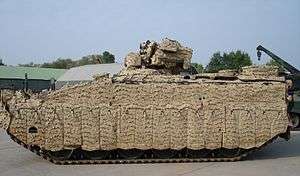Multi-spectral camouflage

Multi-spectral camouflage is the use of counter-surveillance techniques to conceal objects from detection across several parts of the electromagnetic spectrum at the same time. While traditional military camouflage attempts to hide an object in the visible spectrum, multi-spectral camouflage also tries to simultaneously hide objects from detection methods such as infrared, radar, and millimetre-wave radar imaging.[1][2]
Among animals, both insects such as the eyed hawk-moth, and vertebrates such as tree frogs possess camouflage that works in the infra-red as well as in the visible spectrum.
History

The English zoologist Hugh Cott, in his 1940 book Adaptive Coloration in Animals, wrote that some caterpillars such as the eyed hawk-moth Smerinthus ocellatus, and tree frogs such as the red-snouted treefrog Hyla coerulea, are coloured so as to blend with their backgrounds whether observed in visible light or in infra-red.[3][4] Cott noted the importance of camouflage in the infra-red, given the ability of tactical reconnaissance to observe in this part of the spectrum:
Because such screens are effective against direct observation and ordinary photography, by no means does it follow that they will be hidden in the infra-red photograph. Comparison of aerial photographs taken simultaneously on panchromatic and infra-red plates will reveal much that before the advent of this new technique would have been adequately camouflaged...— Hugh Cott, 1940.[5]
A German-led NATO research project concluded in 2004 that while "the multispectral signatures of most military equipment can be significantly reduced by combinations of various camouflage materials", multi-spectral camouflage for individual soldiers remained lacking. The main problems identified were operational constraints such as mobility, weight, and the soldier's physiology.[6]
Camouflage
Multi-spectral camouflage can be applied to individuals in the form of a ghillie suit, disguising the heat given off by the wearer's body, and to vehicles and buildings with either specialised paints or camouflage nets that reduce the amount of heat given off by an object, as well as altering the shape and size of its radar signature.[7][8][9][10][11] The SAAB Barracuda Mobile Camouflage System provides a degree of concealment in the visible, thermal infrared, and radar parts of the electromagnetic spectrum,[12] as does the Miranda Berberys-R multispectral camouflage system from Poland.[13]
Examples across the electromagnetic spectrum
| Electromagnetic spectrum[14] | ||||
| Name | Wavelength | Detected by | Camouflage Technology | Example application |
|---|---|---|---|---|
| Ultraviolet | 10 nm – 380 nm | |||
| Visible light | 380 nm – 700 nm | Eyes, cameras | Paint, nets, etc | Uniforms |
| Shorter Infrared | 700 nm – 3 µm | Image intensifiers | Peltier cooling plates | Adaptiv |
| Mid or Thermal infrared | 3 µm – 8 µm | Heat-seeking missile | ||
| Long infrared | 8 µm – 15 µm | Thermal imaging sensor | ||
| Far infrared | 15 µm – 1 mm | |||
| Microwave | 1 mm – 1 m | Radar | Stealth technology | Northrop Grumman B-2 Spirit, F-117 Nighthawk |
| Longer Radio waves | 1 m – 100,000 km | |||
See also
References
- ↑ Shabbir, Usman. "Highlights from IDEAS 2002". ACIG Special Reports. Air Combat Information Group. Retrieved 30 April 2013.
- ↑ A US 4287243 A, Nielsen, Willi G., "Mat for multispectral camouflage of objects and permanent constructions", published Sep 1, 1981
- ↑ Ramana Rao, J.V. "Introduction to Camouflage & Deception" (PDF). Defence Research and Development Organisation (India). p. 116. Retrieved 13 June 2014.
- ↑ Cott, Hugh B. (1940). Adaptive Coloration in Animals. Oxford University Press. p. Plate 5 shows the eyed hawk-moth caterpillar in visible and infra-red on a leafly background; Plate 6 shows a tree-frog similarly. It is clear from the plates that these animals reflect infra-red.
- ↑ Cott, Hugh B. (1940). Adaptive Coloration in Animals. Oxford University Press. p. 10.
- ↑ "RTO-TM-SCI-096 - Multispectral Camouflage for the Soldier System". NATO RTO Task Group. Retrieved 25 January 2014.
- ↑ "Anti Thermal IR Coating". Motley-Exim Co. Retrieved 30 April 2013.
- ↑ "Winter Camouflage Nets". Saab Group. Retrieved 30 April 2013.
- ↑ "Multispectral Camouflage for the Soldier System (SCI-096)". NATO RTO Task Group. Retrieved 30 April 2013.
- ↑ "Camouflage net". BLÜCHER SYSTEMS®. Retrieved 30 April 2013.
- ↑ "Multispectral Camouflage Nets". Raksha Supreme Camouflage. Retrieved 30 April 2013.
- ↑ "MCS Mobile Camouflage System: Protection on the Move". SAAB Group. 2013. Retrieved 6 January 2014.
- ↑ "Producer's leaflet" (in Polish)
- ↑ Nave, C.R. "The Electromagnetic Spectrum". HyperPhysics. Hosted by Georgia State University Department of Physics and Astronomy. Retrieved 30 April 2013.
